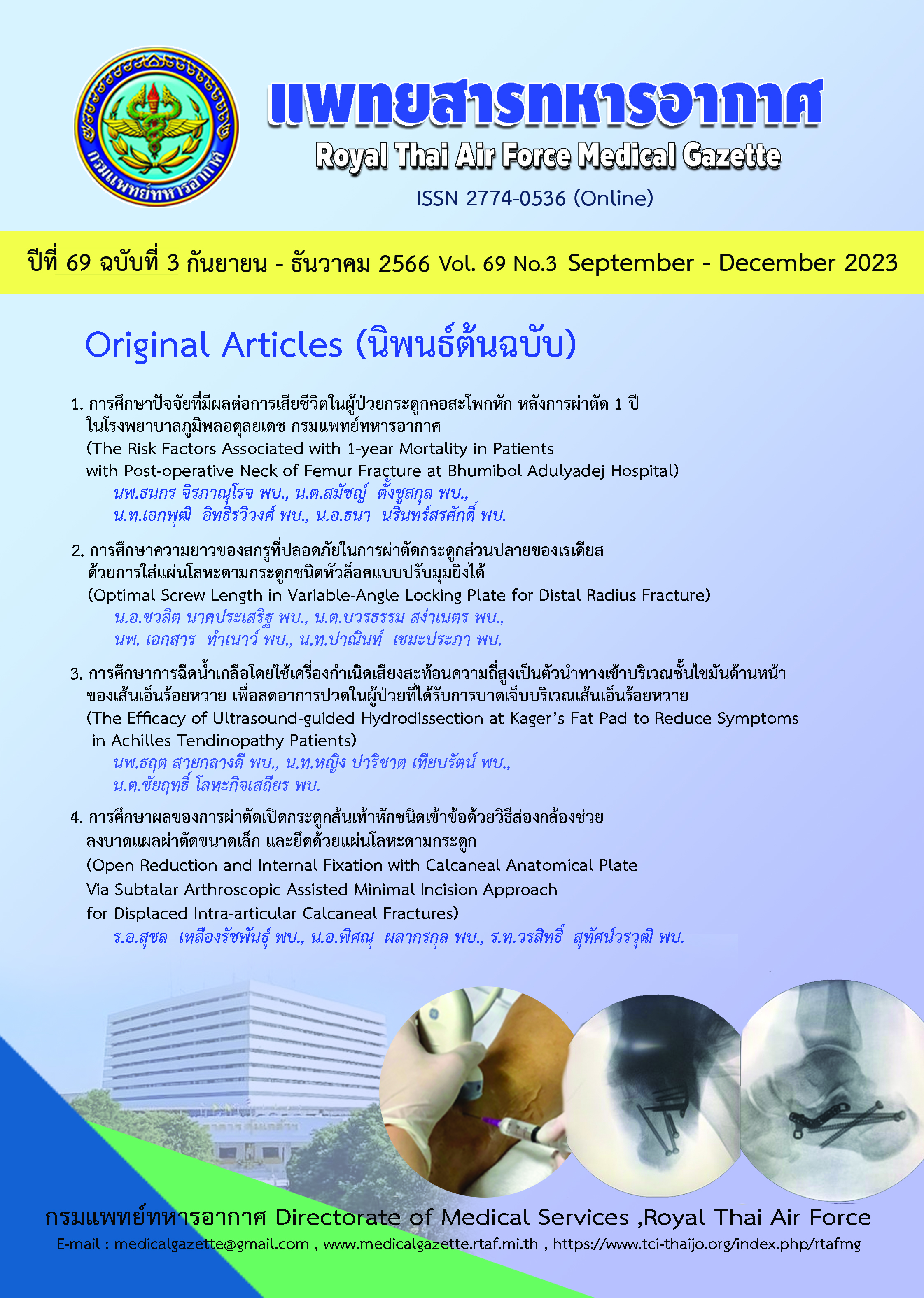The Efficacy of Ultrasound-guided Hydrodissection at Kager’s fat pad to reduce symptom in Achilles tendinopathy patients
Main Article Content
Abstract
Background : Achilles tendinopathy is one of the most common cause of foot and ankle disability. Conservative treatment is recommended as many patient’s pain and function will improve such as stretching, orthotics, medication etc. However, there were many patients poorly responsive to standard management. Recently, case series study, ultrasound-guided hydrodissection at Kager’s fat-pad can produce pain relief in the Achilles tendinopathy patients. Therefore, we interested in this technique may reduce symptoms in our Achilles tendinopathy patients.
Methods : The study-enrolled patients showed persistent pain for more than 3 months after to all conservative treatment in the Achilles tendon. All patients were accessed for plain film of the affected heels and document the presence or absence of calcaneal spur and other information about foot deformity). VAS and FFI-TH data were performed by patient before treatment. Evaluated complication for 1 week after ultrasound-guided hydrodissection at out patient department, VAS and FFI-TH were accessed again at this visit. Finally, 2 weeks and 4 weeks after treatment, we review VAS and FFI-TH by telephone visited.
Result : Enroll of thirteen suitable candidates, 6 male (46%) and 7 female (54%) patients, the median of age was 45 years (range : 34-62). 9 patients was insertional Achilles tendinopathy (69%). Initial median VAS and FFI-TH were 5.98 and 160.77 respectively. At 1 week follow-up, the median of VAS was 5.45 that significant improvement in pain score (P-value = 0.02) but not significantly different from 2 and 4 weeks after Hydrodissetion. The median FFI-TH before intervention comparing with 1,2 and 4 weeks follow-up were significantly different (P-value = 0.03, 0.01, 0.01 in the same order). There were no adverse effect or complication event along in this study.
Conclusion : From the research, we found that Ultrasound-guided Hydrodissection at Kager’s fat pad can reduce symptoms in both insertional and non-insertional Achilles tendinopathy patients at a short time period, but in 4 weeks follow-up, the outcome of foot functional score was improved.
Article Details

This work is licensed under a Creative Commons Attribution-NonCommercial-NoDerivatives 4.0 International License.
บทความที่ได้รับการตีพิมพฺเป็นลิขสิทธิ์ของวารสาร
References
Saltzman CL, Tearse DS. Achilles tendon injuries. J Am Acad Orthop Surg. 1998;6(5):316-25.
Chen TM, Rozen WM, Pan WR, Ashton MW, Richardson MD, Taylor GI. Thearterial anatomy of the Achilles
tendon: anatomical study and clinical implications. Clin Anat. 2009;22(3):377-85.
Courville XF, Coe MP, Hecht PJ. Current concepts review: noninsertional Achilles tendinopathy. Foot Ankle Int
;30(11):1132-42.
de Jonge S, van den Berg C, de Vos RJ. Incidence of midportion Achilles tendinopathy in the general population.
Br J Sports Med 2011;45:1026-8.
Holmes GB, Lin J. Etiologic factors associated with symptomatic Achilles tendinopathy. Foot Ankle Int
;27(11):952-9.
Nahum MB, Robert PG. Current ultrasound application in the foot and ankle. Orthop Clin N AM. 2018;109-21.
Roche AJ, Calder JF. Achilles tendinopathy: a review of the current concepts of treatment. Bone Joint J
;95(10):1299-307.
Evers S, Thoreson AR, Smith J, Zhao C, Geske JR, Amadio PC. Ultrasound-guided hydrodissection decreases
gliding resistance of the median nerve within the carpal tunnel. Muscle Nerve. 2018;57(1):25-32.
Leung JL, Griffith JF. Sonography of Chronic Achilles Tendinopathy. J Clin Ultrasound. 2008;36(1):27-32.
Jones D, Brolinson PG, Patton S, Wong C. Hydrodissection of an Achilles tendinopathy on a professional athlete.
MOJ Orthop Rheumatol. 2017;8(1):00297.
Drakonaki EE, Allen GM, Watura R. Roland Watuia. Ultrasound-guided intervention in the ankle and foot. Br J
Radiol. 2016;89(1057):20150577.
Sanderson LM, Bryant A. Effectiveness and safety of prolotherapy injection for management of lower limb
tendinopathy and fasciopathy. A systematic review. J Foot Ankle Res. 2015;5:57.
Pitchanart S, Araya J, Siriporn J. Reliability and Validity of Foot Functional Index Thai Version. J Med Assoc Thai
;101(2):253-60.


